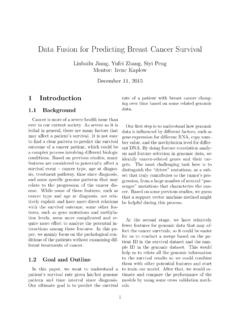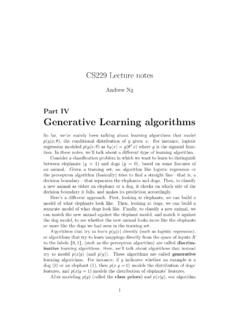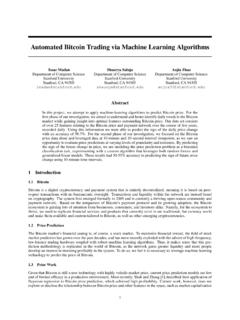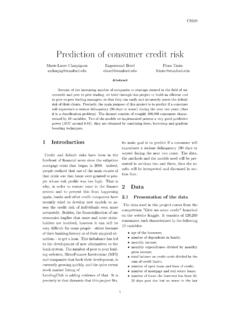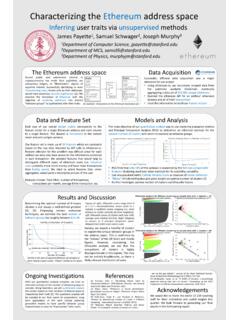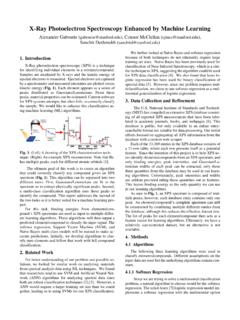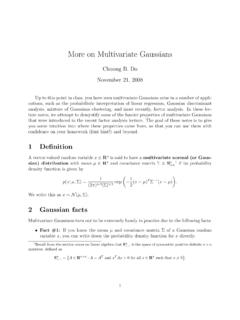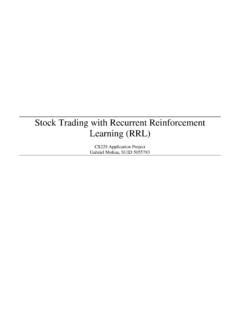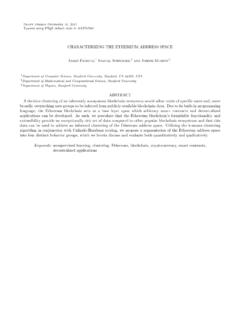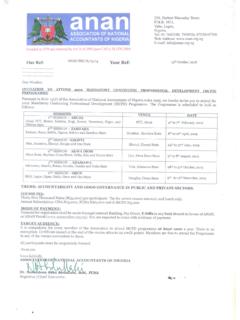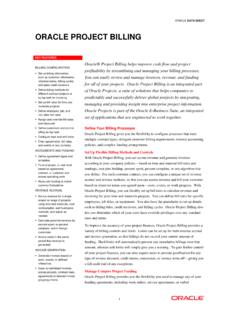Transcription of PartVII Regularizationand model selection - Machine learning
1 CS229 Lecture notes Andrew Ng Part VII. Regularization and model selection Suppose we are trying to select among several different models for a learning problem. For instance, we might be using a polynomial regression model h (x) = g( 0 + 1 x + 2 x2 + + k xk ), and wish to decide if k should be 0, 1, .. , or 10. How can we automatically select a model that represents a good tradeoff between the twin evils of bias and variance1 ? Alternatively, suppose we want to automatically choose the bandwidth parameter for locally weighted regression, or the parameter C for our 1 -regularized SVM. How can we do that? For the sake of concreteness, in these notes we assume we have some finite set of models M = {M1 , .. , Md } that we're trying to select among. For instance, in our first example above, the model Mi would be an i-th order polynomial regression model . (The generalization to infinite M is not ) Alternatively, if we are trying to decide between using an SVM, a neural network or logistic regression, then M may contain these models.
2 1. Given that we said in the previous set of notes that bias and variance are two very different beasts, some readers may be wondering if we should be calling them twin evils here. Perhaps it'd be better to think of them as non-identical twins. The phrase the fraternal twin evils of bias and variance doesn't have the same ring to it, though. 2. If we are trying to choose from an infinite set of models, say corresponding to the possible values of the bandwidth R+ , we may discretize and consider only a finite number of possible values for it. More generally, most of the algorithms described here can all be viewed as performing optimization search in the space of models, and we can perform this search over infinite model classes as well. 1. 2. 1 Cross validation Let's suppose we are, as usual, given a training set S. Given what we know about empirical risk minimization, here's what might initially seem like a algorithm, resulting from using empirical risk minimization for model selec- tion: 1.
3 Train each model Mi on S, to get some hypothesis hi . 2. Pick the hypotheses with the smallest training error. This algorithm does not work. Consider choosing the order of a poly- nomial. The higher the order of the polynomial, the better it will fit the training set S, and thus the lower the training error. Hence, this method will always select a high-variance, high-degree polynomial model , which we saw previously is often poor choice. Here's an algorithm that works better. In hold-out cross validation (also called simple cross validation), we do the following: 1. Randomly split S into Strain (say, 70% of the data) and Scv (the remain- ing 30%). Here, Scv is called the hold-out cross validation set. 2. Train each model Mi on Strain only, to get some hypothesis hi . 3. Select and output the hypothesis hi that had the smallest error Scv (hi ). on the hold out cross validation set.
4 (Recall, Scv (h) denotes the empir- ical error of h on the set of examples in Scv .). By testing on a set of examples Scv that the models were not trained on, we obtain a better estimate of each hypothesis hi 's true generalization error, and can then pick the one with the smallest estimated generalization error. Usually, somewhere between 1/4 1/3 of the data is used in the hold out cross validation set, and 30% is a typical choice. Optionally, step 3 in the algorithm may also be replaced with selecting the model Mi according to arg mini Scv (hi ), and then retraining Mi on the entire training set S. (This is often a good idea, with one exception being learning algorithms that are be very sensitive to perturbations of the initial conditions and/or data. For these methods, Mi doing well on Strain does not necessarily mean it will also do well on Scv , and it might be better to forgo this retraining step.)
5 The disadvantage of using hold out cross validation is that it wastes . about 30% of the data. Even if we were to take the optional step of retraining 3. the model on the entire training set, it's still as if we're trying to find a good model for a learning problem in which we had training examples, rather than m training examples, since we're testing models that were trained on only examples each time. While this is fine if data is abundant and/or cheap, in learning problems in which data is scarce (consider a problem with m = 20, say), we'd like to do something better. Here is a method, called k-fold cross validation, that holds out less data each time: 1. Randomly split S into k disjoint subsets of m/k training examples each. Let's call these subsets S1 , .. , Sk . 2. For each model Mi , we evaluate it as follows: For j = 1, .. , k Train the model Mi on S1 Sj 1 Sj+1 Sk ( , train on all the data except Sj ) to get some hypothesis hij.
6 Test the hypothesis hij on Sj , to get Sj (hij ). The estimated generalization error of model Mi is then calculated as the average of the Sj (hij )'s (averaged over j). 3. Pick the model Mi with the lowest estimated generalization error, and retrain that model on the entire training set S. The resulting hypothesis is then output as our final answer. A typical choice for the number of folds to use here would be k = 10. While the fraction of data held out each time is now 1/k much smaller than before this procedure may also be more computationally expensive than hold-out cross validation, since we now need train to each model k times. While k = 10 is a commonly used choice, in problems in which data is really scarce, sometimes we will use the extreme choice of k = m in order to leave out as little data as possible each time. In this setting, we would repeatedly train on all but one of the training examples in S, and test on that held-out example.
7 The resulting m = k errors are then averaged together to obtain our estimate of the generalization error of a model . This method has its own name; since we're holding out one training example at a time, this method is called leave-one-out cross validation. Finally, even though we have described the different versions of cross vali- dation as methods for selecting a model , they can also be used more simply to evaluate a single model or algorithm. For example, if you have implemented 4. some learning algorithm and want to estimate how well it performs for your application (or if you have invented a novel learning algorithm and want to report in a technical paper how well it performs on various test sets), cross validation would give a reasonable way of doing so. 2 Feature selection One special and important case of model selection is called feature selection . To motivate this, imagine that you have a supervised learning problem where the number of features n is very large (perhaps n m), but you suspect that there is only a small number of features that are relevant to the learning task.
8 Even if you use a simple linear classifier (such as the perceptron) over the n input features, the VC dimension of your hypothesis class would still be O(n), and thus overfitting would be a potential problem unless the training set is fairly large. In such a setting, you can apply a feature selection algorithm to reduce the number of features. Given n features, there are 2n possible feature subsets (since each of the n features can either be included or excluded from the subset), and thus feature selection can be posed as a model selection problem over 2n possible models. For large values of n, it's usually too expensive to explicitly enumerate over and compare all 2n models, and so typically some heuristic search procedure is used to find a good feature subset. The following search procedure is called forward search: 1. Initialize F = . 2. Repeat {. (a) For i = 1, .. , n if i 6 F , let Fi = F {i}, and use some ver- sion of cross validation to evaluate features Fi.}
9 ( , train your learning algorithm using only the features in Fi , and estimate its generalization error.). (b) Set F to be the best feature subset found on step (a). }. 3. Select and output the best feature subset that was evaluated during the entire search procedure. 5. The outer loop of the algorithm can be terminated either when F =. {1, .. , n} is the set of all features, or when |F | exceeds some pre-set thresh- old (corresponding to the maximum number of features that you want the algorithm to consider using). This algorithm described above one instantiation of wrapper model feature selection , since it is a procedure that wraps around your learning algorithm, and repeatedly makes calls to the learning algorithm to evaluate how well it does using different feature subsets. Aside from forward search, other search procedures can also be used. For example, backward search starts off with F = {1.
10 , n} as the set of all features, and repeatedly deletes features one at a time (evaluating single-feature deletions in a similar manner to how forward search evaluates single-feature additions) until F = . Wrapper feature selection algorithms often work quite well, but can be computationally expensive given how that they need to make many calls to the learning algorithm. Indeed, complete forward search (terminating when F = {1, .. , n}) would take about O(n2 ) calls to the learning algorithm. Filter feature selection methods give heuristic, but computationally much cheaper, ways of choosing a feature subset. The idea here is to compute some simple score S(i) that measures how informative each feature xi is about the class labels y. Then, we simply pick the k features with the largest scores S(i). One possible choice of the score would be define S(i) to be (the absolute value of) the correlation between xi and y, as measured on the training data.
